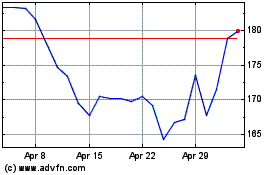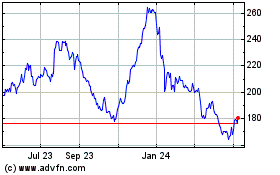Factory Orders Point to Slowdown -- WSJ
25 May 2019 - 5:02PM
Dow Jones News
By Paul Kiernan and Patrick McGroarty
This article is being republished as part of our daily
reproduction of WSJ.com articles that also appeared in the U.S.
print edition of The Wall Street Journal (May 25, 2019).
WASHINGTON -- The U.S. economic slowdown widely forecast for the
first quarter may be arriving in the second, driven by faltering
industrial activity.
Orders for so-called durable goods -- manufactured products
designed to last at least three years, such as cars, appliances and
commercial aircraft -- tumbled 2.1% from the prior month to a
seasonally adjusted $248.4 billion in April, the Commerce
Department said Friday. The government also said such orders grew
less than previously estimated in March, painting a weaker picture
of U.S. factory demand than anticipated.
Much of the decline owed to the volatile civilian-aircraft
component, which dropped 25% from March following a decision by
global aviation authorities to ground Boeing Co.'s 737 MAX airliner
after a pair of fatal crashes. The company didn't log any
commercial orders for 737 planes in March or April, the first
months without a sale of its best-selling aircraft in seven years.
Boeing in April cut production of the MAX by a fifth, likely
putting it behind Airbus SE this year as the world's biggest plane
maker.
But the aircraft sales were just one piece of a broader picture.
The new data follow others showing recent declines in factory
output and business activity broadly, suggesting the economy is
losing momentum after expanding at a robust 3.2% annual rate
clocked in the first quarter. Research firm Macroeconomic Advisers
lowered its estimate of second-quarter growth to a 1.7% pace from
1.9% in the wake of Friday's report.
Though manufacturing accounts for a small share of gross
domestic product, the sector is highly sensitive to shifts in
demand, making it a bellwether for the broader U.S. economy. Though
the U.S. job market remained strong in April -- with unemployment
falling to a five-decade low of 3.6% -- spending at U.S. retailers
fell, showing some consumer hesitation as the second quarter
began.
Many forecasters had projected economic growth to slow from last
year's pace, which was spurred by a strong labor market, tax cuts
and federal spending increases. They expected some of those effects
to wane, while the lagged impact of the Fed's four interest-rate
increases last year ripple through the economy. The U.S. trade
fight with China is also clouding the economic outlook.
"We've been expecting the economy to slow over the course of
this year for some time, mainly because of domestic factors," says
Andrew Hunter, senior U.S. economist at Capital Economics. "But I
think the downside risks have really increased over the past few
weeks with the escalation of trade tensions."
Boeing isn't the only big manufacturer seeing softer sales.
Harley-Davidson Inc. said on April 23 that U.S. retail sales of its
motorcycles fell 4% in the first quarter, extending a long decline
in its biggest market. And tractor maker Deere & Co. on May 17
said it would cut production by 20% this year to reflect lower
demand from farmers facing the steepest downturn for the
agricultural economy in decades.
The Federal Reserve said last week that industrial production --
the broadest measure of output from factories, mines and utilities
-- fell in three of the first four months of 2019. Factory
production alone is down over the period. A report Thursday showed
activity in U.S. manufacturing and service sectors falling to a
three-year low in May and noted an uptick in uncertainty weighing
on business confidence.
The durable goods report Friday showed a closely watched measure
of business investment -- new orders for nondefense capital goods
excluding aircraft -- slipped 0.9% last month and was revised lower
for March. That left the year-over-year gain in the category at
1.3%, the smallest since January 2017.
Many economists say the outlook for capital investment is
unlikely to improve in the near term given the Trump
administration's decision this month to increase tariffs on goods
imported from China. While the full impact remains unclear,
economists say the levies could disrupt complex business-supply
chains and drive up prices for at least some consumer goods.
"My suspicion is that businesses are holding off on key
investment decisions due to uncertainty surrounding the trade
negotiations," said Stephen Stanley, chief economist at Amherst
Pierpont Securities, in a note to clients. "Now that negotiations
have broken down, there is further reason why firms might be
inclined to sit on their hands for a while."
Corrections & Amplifications The U.S. unemployment rate fell
to a five-decade low of 3.6% in April. An earlier version of this
story incorrectly said it had declined to a half-decade low. (May
24)
Write to Paul Kiernan at paul.kiernan@wsj.com and Patrick
McGroarty at patrick.mcgroarty@wsj.com
(END) Dow Jones Newswires
May 25, 2019 02:47 ET (06:47 GMT)
Copyright (c) 2019 Dow Jones & Company, Inc.
Boeing (NYSE:BA)
Historical Stock Chart
From Mar 2024 to Apr 2024

Boeing (NYSE:BA)
Historical Stock Chart
From Apr 2023 to Apr 2024
